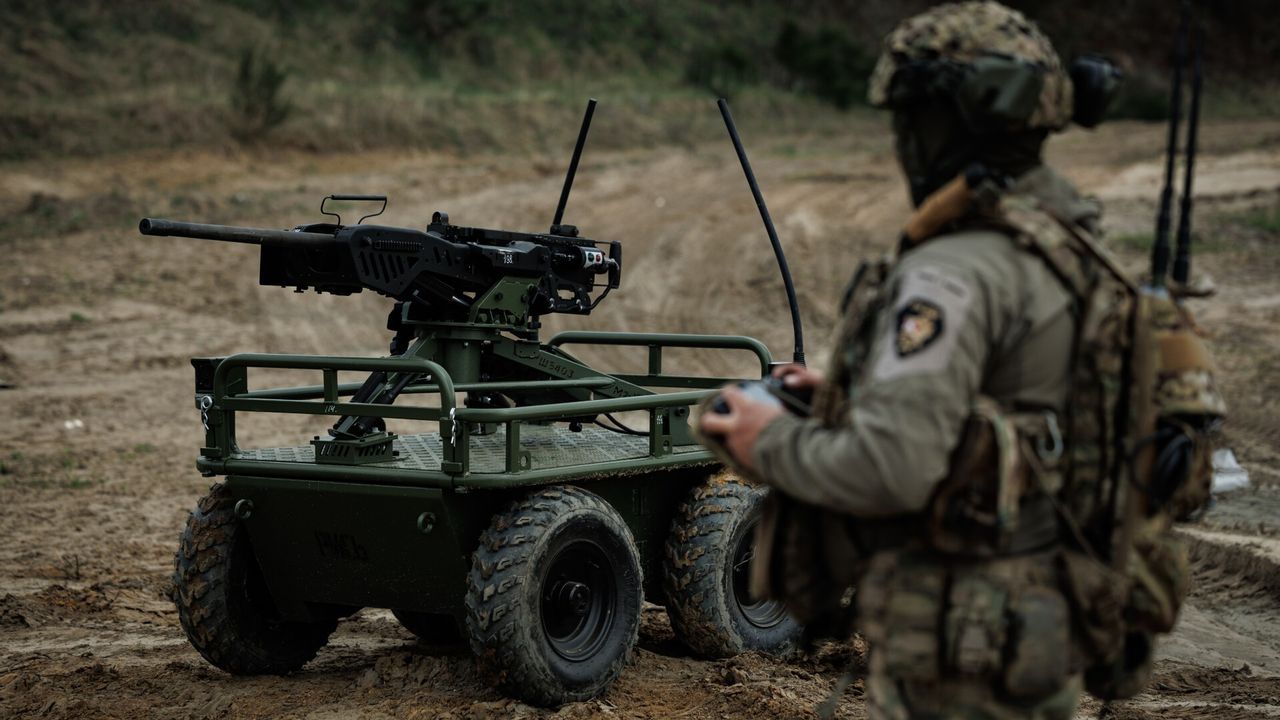Science
Ukraine Innovates to Boost Robot Performance Amid Starlink Limitations

Ukraine’s military operations are facing challenges due to the bandwidth limitations of SpaceX’s Starlink satellite internet. These restrictions hinder the performance of unmanned ground vehicles (UGVs) deployed on the frontline against Russian forces. As a result, Ukrainian tech innovators are seeking alternative solutions to enhance the effectiveness of these robotic systems.
Over the past year, Ukraine has sent thousands of wheeled ground robots to support its military efforts. These UGVs assist in delivering supplies, evacuating injured personnel, and, in some instances, engaging in combat. However, the bandwidth available from Starlink terminals is often insufficient, providing as little as 10 megabits per second. This limitation leads to poor video feeds, which are critical for the precise control of the robots.
Vadym Burukin, a technologist and CEO of the drone startup Huless, highlighted the risks associated with low frame rates. “If you want to drive fast, you need a frame rate of at least 30 frames per second to control the robot effectively,” he stated. “With only ten frames per second, there is a significant chance of navigating into dangerous areas, such as minefields.”
Starlink has played a pivotal role in keeping Ukrainian forces connected since the onset of the conflict. It has facilitated communication among troops and supported the operation of FPV drones and other unmanned systems. According to sources linked with the Ukrainian Ministry of Defense, approximately 200,000 Starlink terminals are currently operational in Ukraine, making it the largest user of Starlink services in Europe.
Despite this extensive deployment, the sheer volume of devices, especially near the frontlines, slows the robots to a maximum speed of roughly 6 miles per hour (10 kilometers per hour). Andriy Dovbenko, CEO of the Ukrainian Tech Exchange network, noted that this sluggish speed prolongs missions, particularly when traversing the 12-mile-wide (20-kilometer) grey zone, where risks from Russian FPV drones are ever-present. “You want to have at least 20 kilometers per hour (24 miles per hour) for unmanned ground vehicles,” Dovbenko emphasized.
The Starlink terminals also face operational challenges due to environmental factors. Terrain vibrations can affect performance, and adverse weather conditions, such as clouds and rain, can degrade the signal further.
In response to these issues, Ukrainian innovators are developing alternative technologies. Burukin and his team have created tethered drones that can ascend to 500 feet (150 meters) to carry signal repeaters. These devices can significantly amplify radio signals, extending their range from just a couple of kilometers to over 40 kilometers (25 miles).
This innovation allows for increased operational flexibility, enabling Ukrainian forces to conduct exploratory missions deeper into Russian-controlled areas without losing connection. Burukin shared a recent success where drones equipped with this technology managed to reach the Donbas Arena, located 30 miles (50 kilometers) from the current frontline.
Despite these advancements, Dovbenko maintains that Starlink remains essential for Ukrainian operations. He acknowledged the technology’s limitations, stating, “There are many uses for Starlink in the war, but it hasn’t been developed specifically as a military technology. It would be beneficial to have alternatives, but can we really produce a scalable alternative to Starlink? Probably not.”
As the conflict continues, the integration of artificial intelligence into military operations is anticipated to further enhance the capabilities of UGVs. AI-powered autonomous navigation systems may soon allow robots to operate without real-time human oversight, providing resilience against signal loss and jamming.
While fully autonomous systems are not expected to replace human soldiers, they will likely reduce the number of personnel required in high-risk frontline positions. Ukrainian innovators are optimistic that these advancements will help safeguard lives while maintaining operational effectiveness in the ongoing conflict.
-

 World2 weeks ago
World2 weeks agoGlobal Air Forces Ranked by Annual Defense Budgets in 2025
-

 World2 weeks ago
World2 weeks agoMass Production of F-35 Fighter Jet Drives Down Costs
-

 Top Stories2 weeks ago
Top Stories2 weeks agoNew ‘Star Trek: Voyager’ Game Demo Released, Players Test Limits
-

 Top Stories2 weeks ago
Top Stories2 weeks agoDirecTV to Launch AI-Driven Ads with User Likenesses in 2026
-

 Science2 weeks ago
Science2 weeks agoTime Crystals Revolutionize Quantum Computing Potential
-

 Lifestyle1 week ago
Lifestyle1 week agoDiscover Reese Witherspoon’s Chic Dining Room Style for Under $25
-

 World2 weeks ago
World2 weeks agoElectrification Challenges Demand Advanced Multiphysics Modeling
-

 Lifestyle2 weeks ago
Lifestyle2 weeks agoLia Thomas Honored with ‘Voice of Inspiration’ Award at Dodgers Event
-

 Entertainment2 weeks ago
Entertainment2 weeks agoFreeport Art Gallery Transforms Waste into Creative Masterpieces
-

 Health1 week ago
Health1 week agoGavin Newsom Critiques Trump’s Health and National Guard Plans
-

 Entertainment2 weeks ago
Entertainment2 weeks agoFast & Furious Coaster Hits the Track at Universal Studios
-

 Health2 weeks ago
Health2 weeks agoResearchers Uncover New Insights into Cancer Mortality Causes









